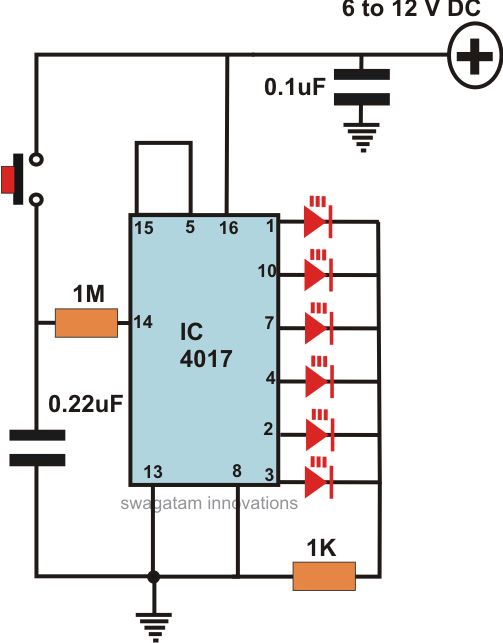
how to build a simple led light chaser circuit

This article offers a circuit diagram and a discussion on CMOS logic and IC layout for creating a set of attention-getting LED running lights. It details a simple sequential LED flasher or light chaser that can be built, including the necessary parts list. The core component of the project is the CMOS 4017 Logic IC, which is paired with a CMOS 4049 oscillator.
The schematic for the LED running lights features the CMOS 4017 decade counter, which is designed to sequentially activate a series of LEDs in a chaser pattern. The 4017 IC operates by counting clock pulses generated by the 4049 oscillator, which serves as a square wave generator. This oscillator can be configured to produce a desired frequency, thus controlling the speed of the LED sequence.
In the circuit, the output pins of the 4017 are connected to individual LEDs, which are typically arranged in a linear or circular pattern for visual effect. Each output pin corresponds to a specific LED, turning it on in succession as the counter increments. The circuit can be enhanced with resistors to limit current through the LEDs, ensuring they operate within safe limits.
The design may also include a capacitor connected to the oscillator to stabilize the frequency and improve performance. A power supply, typically 9V or 12V, is required to power the circuit, and appropriate bypass capacitors should be placed near the ICs to filter out noise and stabilize operation.
The schematic should also include a brief explanation of how to set up the components on a breadboard or PCB, along with any necessary connections for the power supply and ground. With careful assembly, this circuit can effectively create an eye-catching display of running lights suitable for various applications, such as automotive lighting or decorative displays.Want to make a set of attention-getting LED running lights? This article provides a circuit diagram and discussion of the CMOS logic and IC layout for a simple sequential LED flasher or light chaser that one can build, including the parts lists. The heart of the project is the CMOS 4017 Logic IC paired to an IC 4049 oscillator.. 🔗 External reference
The schematic for the LED running lights features the CMOS 4017 decade counter, which is designed to sequentially activate a series of LEDs in a chaser pattern. The 4017 IC operates by counting clock pulses generated by the 4049 oscillator, which serves as a square wave generator. This oscillator can be configured to produce a desired frequency, thus controlling the speed of the LED sequence.
In the circuit, the output pins of the 4017 are connected to individual LEDs, which are typically arranged in a linear or circular pattern for visual effect. Each output pin corresponds to a specific LED, turning it on in succession as the counter increments. The circuit can be enhanced with resistors to limit current through the LEDs, ensuring they operate within safe limits.
The design may also include a capacitor connected to the oscillator to stabilize the frequency and improve performance. A power supply, typically 9V or 12V, is required to power the circuit, and appropriate bypass capacitors should be placed near the ICs to filter out noise and stabilize operation.
The schematic should also include a brief explanation of how to set up the components on a breadboard or PCB, along with any necessary connections for the power supply and ground. With careful assembly, this circuit can effectively create an eye-catching display of running lights suitable for various applications, such as automotive lighting or decorative displays.Want to make a set of attention-getting LED running lights? This article provides a circuit diagram and discussion of the CMOS logic and IC layout for a simple sequential LED flasher or light chaser that one can build, including the parts lists. The heart of the project is the CMOS 4017 Logic IC paired to an IC 4049 oscillator.. 🔗 External reference





